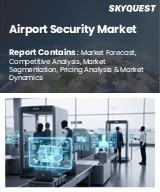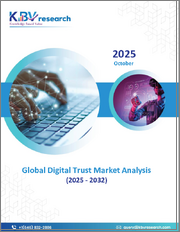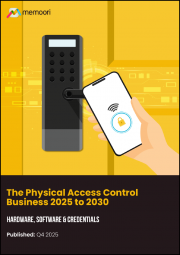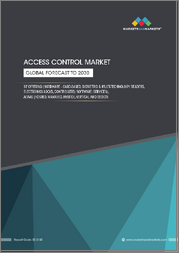
|
시장보고서
상품코드
1851497
액세스 컨트롤 : 시장 점유율 분석, 산업 동향, 통계, 성장 예측(2025-2030년)Access Control - Market Share Analysis, Industry Trends & Statistics, Growth Forecasts (2025 - 2030) |
||||||
액세스 컨트롤 시장 규모는 2025년에 38억 달러, 2030년에는 56억 1,000만 달러에 이를 것으로 예상되며, 예측 기간 동안 CAGR은 8.10%를 나타낼 전망입니다.

기업, 공공기관, 중요 인프라 시설에서 클라우드 관리, 모바일 자격 증명 및 생체 인식이 기존의 키와 카드를 대체함에 따라 수요가 치열 해지고 있습니다. 향상된 데이터 보호 규제, 비접촉식 사용자 경험의 중요성, 비디오 감시와의 융합으로 업그레이드 사이클이 향상되었습니다. 반도체 부족과 관련된 가격 상승은 공급망 위험을 줄이면서 미래에 자본 지출을 보장하는 소프트웨어 정의 아키텍처로 구매자를 유도하고 있습니다.
세계의 액세스 컨트롤 시장 동향과 인사이트
GDPR(EU 개인정보보호규정)의 영향을 받기 쉬운 EU 데이터센터의 전자 액세스 규제 강화
2024년 10월에 발효된 NIS2 지침은 모든 물리적 진입점에 대해 다중 요소 인증 및 탬퍼링 방지 감사 추적을 요구합니다. 데이터센터 사업자는 암호화 및 지속적인 모니터링 조항을 충족하기 위해 기존 카드에서 생체 인식 및 모바일 인증으로의 전환을 가속화하고 있습니다. 공급업체공급망 모니터링은 조달 임계값을 높이고 자동화된 컴플라이언스 보고서를 제공하는 플랫폼에 대한 수요를 조타합니다. NIS2와 GDPR(EU 개인정보보호규정)의 시너지 효과는 물리적 보안을 수행하면서 개인 데이터를 보호하는 통합 솔루션에 대한 프리미엄을 창출하여 전체 액세스 컨트롤 시장의 교환 예산을 증가시킵니다.
북미 기업 부동산에서 비접촉식 모바일 자격 증명 보급
상업시설의 주택은 개찰구, 엘리베이터, 스위트 룸의 잠금을 해제하는 Apple Wallet 및 Google Pay 자격 증명을 발급합니다. 원격 프로비저닝은 배지 발행 비용을 줄이고 유연한 좌석 정책을 지원합니다. 암호화된 무선 업데이트를 통해 시설 팀은 분실된 휴대폰을 즉시 비활성화하고 입주자의 편의성을 높이면서 보안을 강화할 수 있습니다. 기존 스마트폰 인프라와 호환되므로 카드 프린터 오버헤드가 없어지고 비즈니스 사례가 향상됩니다. 신속한 도입 사이클은 비즈니스 효율성의 눈에 띄는 향상으로 이어져 액세스 컨트롤 시장의 기세를 더욱 강화하고 있습니다.
EU 클라우드 배포의 사이버 보안 컴플라이언스 비용(NIS2)
클라우드 호스팅 액세스 플랫폼은 NIS2를 충족하기 위해 지속적인 위협 모니터링, 보안 코드 서명 및 문서화된 개발 파이프라인을 추가해야 하며 공급업체의 운영 비용을 15-20% 늘립니다. 소규모 공급업체는 감사 비용 및 침입 테스트 비용을 흡수하는 데 어려움을 겪고 있으며 구매자가 인증된 인프라가 있는 세계 브랜드에 끌릴 수 있도록 통합이 진행됩니다. 일부 EU 기업들은 업그레이드를 연기하고 교체 주기를 늘려 액세스 컨트롤 시장의 성장 전망을 약간 약화시키고 있습니다.
부문 분석
물리적 배치에서 전자 잠금, 컨트롤러 및 생체 인식 리더의 필요성을 반영하여 하드웨어는 62.1%의 점유율로 2024년 매출을 견인했습니다. 대학 개보수만으로도 캠퍼스가 모바일 지원 인프라로 이동함에 따라 잠금 업데이트 사이클이 크게 증가했습니다. 전자 락은 핸즈프리 입장을 가능하게 하는 울트라 와이드 밴드 모듈이 원동력이 되어, 가장 급속하게 대수를 늘렸습니다. 바이오메트릭스 멀티센서 리더는 높은 보증 검증이 필요한 연구소나 약국에서 지지를 얻었습니다.
소프트웨어는 2030년까지 연평균 복합 성장률(CAGR) 9.1%를 나타내 관리 콘솔에 예측 분석과 AI 주도의 이상 감지를 추가합니다. 클라우드 제어 플레인은 다른 사이트를 통합하여 실시간 정책 푸시 및 자동 컴플라이언스 감사를 가능하게 합니다. 대시보드의 비디오 액세스 통합은 조사 능력을 강화하고 개방형 API는 생태계 개발을 촉진합니다. 통합 서비스와 정기 지원 계약은 파트너 수익을 확대하고 관리 서비스를 액세스 컨트롤 업계에서 탄력적인 연금층으로 자리 매김합니다.
호스팅형 ACaaS는 2024년 도입의 52.3%를 차지하며 서버 소유보다 예측 가능한 구독을 선호하는 중소기업으로 견인되었습니다. On-Premise 솔루션과 동등한 기능과 자동 업데이트를 통해 IT 부문의 스킬 부담을 경감. 세세한 테넌트 포털은 코워킹 브랜드가 수천 명의 멤버를 동적으로 관리하는 데 도움이 되며 액세스 컨트롤 시장에서 고객 충성도를 높입니다.
하이브리드 ACaaS는 CAGR 8.8%로 가장 급성장한 모델로 클라우드 오케스트레이션과 로컬 에지 스토리지의 균형을 맞추어 규제 대상 기업을 위해 제공됩니다. 병원에서는 네트워크가 다운되는 동안 민감한 로그를 현장 어플라이언스로 라우팅하고 연결이 복구되면 분석을 위해 클라우드에 동기화합니다. 매니지드 ACaaS는 맞춤형 통합이 필요한 복잡한 멀티벤더 에스테이트를 위한 틈새 시장을 유지하고 있지만, 플랫폼은 보다 넓은 액세스 컨트롤 시장에서 섹터를 넘어 확장하는 셀프 서비스 패러다임으로 꾸준히 수렴하고 있습니다.
액세스 컨트롤 시장은 구성 요소별(하드웨어, 소프트웨어, 서비스), 아카아스 배포별(호스팅, 매니지드, 하이브리드), 인증 방식별(싱글 팩터, 멀티 팩터, 모바일 자격 증명), 연결 기술별(RFID/NFC, 스마트 카드, Bluetooth LE, UWB), 최종 사용자 업계별(상업, 산업, 정부, 기타), 지역별로 구분됩니다. 시장 예측은 금액(달러)으로 제공됩니다.
지역별 분석
북미는 기업 캠퍼스, 대학, 병원의 대규모 근대화에 힘입어 2024년 매출 점유율 38.9%를 유지했습니다. 켄튀르키예 대학의 9,000 도어화 등 미국의 고등 교육 기관의 개수는 액세스 컨트롤과 출석 분석을 융합시킨 모바일 대응 플랫폼의 캠퍼스 전체에의 도입을 나타내고 있습니다. 캐나다의 스마트 빌딩 장려책과 멕시코 국경을 넘어선 물류 시설은 더욱 수요를 늘리고 있습니다. UWB와 생체 인식 신흥 기업에 대한 벤처 투자로이 지역은 액세스 컨트롤 시장의 혁신의 최전선에 위치하고 있습니다.
중동은 2030년까지 연평균 복합 성장률(CAGR)이 9.6%로 가장 급성장하고 있는 지역으로 스마트시티 구상과 보안 우선 규제 프레임워크이 뒷받침되고 있습니다. UAE와 사우디아라비아는 물리적 ID를 대체하는 얼굴 인증, 홍채 인증, 지문 인증 시스템을 대규모로 배포하고 있으며, 카타르와 오만은 세계 IoT 커맨드 센터에 액세스 컨트롤를 통합하고 있습니다. 현지 통합업체는 세계 벤더 SDK를 기반으로 지역별 솔루션을 구축하여 시장 현지화를 가속화하고 있습니다.
유럽은 엄격한 프라이버시 법에도 불구하고 꾸준한 성장을 보여줍니다. NIS2와 EU의 AI 방법은 생체인식의 사용에 대한 명시적인 동의와 투명성을 요구합니다. 조직은 하이브리드 ACaaS를 채택하여 기밀성이 높은 바이오메트릭 템플릿을 유럽에 남기는 것으로 대응하고 있습니다. 독일, 프랑스, 영국은 벤더의 잠금을 피하기 위해 개방형 프로토콜 시스템을 선호하며, 북유럽 사업자는 지속 가능한 저전력 리더를 개척하고 있습니다. 동유럽의 교통 허브는 모바일 및 비디오 인증 입장에서 카드 기반 장벽을 업그레이드하여 액세스 컨트롤 시장의 수익을 높이는 데 기여하고 있습니다.
기타 혜택 :
- 엑셀 형식 시장 예측(ME) 시트
- 3개월간의 애널리스트 지원
목차
제1장 서론
- 조사 전제조건과 시장 정의
- 조사 범위
제2장 조사 방법
제3장 주요 요약
제4장 시장 상황
- 시장 개요
- 시장 성장 촉진요인
- GDPR(EU 개인정보보호규정)의 영향을 받기 쉬운 EU의 데이터센터에 있어서 전자 액세스에 관한 규제의 의무화
- 북미의 기업 부동산에 있어서 비접촉형 모바일 크레덴셜의 보급
- 스마트 시티와 중요 인프라 프로그램이 중동의 바이오메트릭스를 뒷받침
- APAC에서의 코워킹 스페이스 확대가 클라우드 기반의 ACaaS를 견인
- IP 비디오 액세스 컨트롤 유럽 교통 허브의 컨버전스 업그레이드
- 미국 고등교육기관에서 노후화된 키카드 시스템의 개수 수요
- 시장 성장 억제요인
- EU의 클라우드 도입에 있어서 사이버 보안 대응 비용(NIS2)
- 보안 MCU 칩 부족이 리더 출하에 영향
- 미국과 EU 국가에서 얼굴 인증에 대한 프라이버시 보호 반발
- 남미의 중소기업 예산 제약
- 공급망 분석
- 기술 스냅샷(진화, RFID vs NFC, 주요 동향)
- 규제와 기술 전망
- Porter's Five Forces
- 공급기업의 협상력
- 구매자의 협상력
- 신규 참가업체의 위협
- 경쟁 기업 간 경쟁 관계
- 대체품의 위협
- 투자 및 자금 조달 분석
제5장 시장 규모와 성장 예측
- 구성 요소별
- 하드웨어
- 카드/근접/스마트 카드 리더
- 생체 인식 리더기(지문, 얼굴, 홍채, 다중 모드)
- 전자식 잠금 장치(자기식, 전기 스트라이크, 데드볼트, 무선 스마트 잠금)
- 컨트롤러 및 패널
- 소프트웨어
- 액세스 컨트롤 관리 제품군
- 영상 관리 통합 플러그인
- 서비스
- 설치 및 통합
- 지원 및 유지 보수
- 하드웨어
- Access Control-as-a-Service(배포)별
- 호스팅형 ACaaS
- 관리형 ACaaS
- 하이브리드 ACaaS
- 인증 방식별
- 단일 요소 인증
- 다중 요소 인증
- 모바일 인증/Bluetooth LE
- 통신 기술별
- RFID/NFC
- 스마트 카드(125 kHz, 13.56 MHz)
- Bluetooth 저에너지
- 초광대역(UWB)
- 최종 사용자 업계별
- 상업 빌딩
- 산업 및 제조
- 정부 및 공공 부문
- 운송 및 물류
- 의료 시설
- 군사 및 방위 시설
- 주택 및 스마트 홈
- 지역별
- 북미
- 미국
- 캐나다
- 멕시코
- 남미
- 브라질
- 아르헨티나
- 기타 남미
- 유럽
- 영국
- 독일
- 프랑스
- 이탈리아
- 스페인
- 기타 유럽
- 아시아태평양
- 중국
- 일본
- 인도
- 한국
- ASEAN
- 호주
- 뉴질랜드
- 기타 아시아태평양
- 중동 및 아프리카
- 중동
- GCC
- 튀르키예
- 이스라엘
- 기타 중동
- 아프리카
- 남아프리카
- 나이지리아
- 이집트
- 기타 아프리카
- 북미
제6장 경쟁 구도
- 시장 집중도
- 전략적 움직임(M&A, 파트너십, 제품 발표)
- 시장 점유율 분석
- 기업 프로파일
- ASSA ABLOY AB
- Johnson Controls International plc(Tyco)
- Honeywell International Inc.
- Dormakaba Holding AG
- Allegion plc
- Bosch Security Systems Inc.
- Thales Group(Gemalto)
- Suprema Inc.
- Hanwha Vision Co. Ltd.
- Schneider Electric SE
- NEC Corporation
- Idemia Group
- Nedap NV
- Axis Communications AB
- Panasonic Connect Co. Ltd.
- Brivo Systems LLC
- Identiv Inc.
- Salto Systems SL
- Siemens Smart Infrastructure
- Genetec Inc.
제7장 시장 기회와 향후 전망
KTH 25.11.21The access control market size is valued at USD 3.80 billion in 2025 and is projected to reach USD 5.61 billion by 2030, registering an 8.10% CAGR over the forecast period.
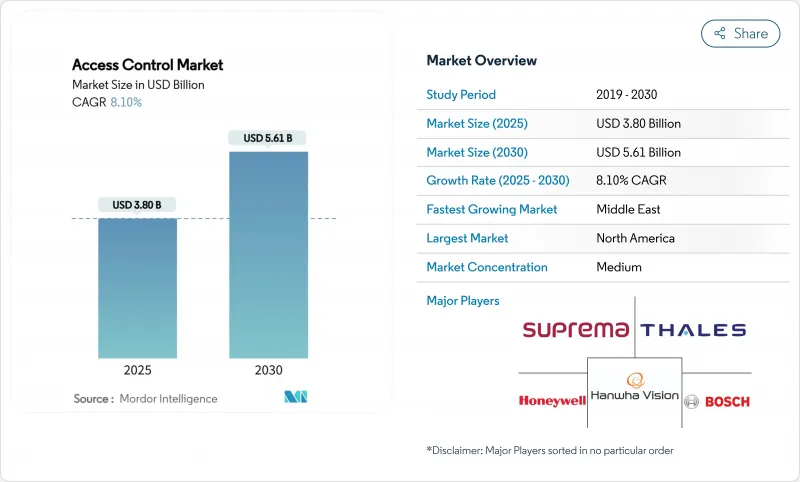
Demand is intensifying as cloud management, mobile credentials and biometrics replace legacy keys and cards across corporate, public-sector and critical-infrastructure facilities. Stricter data-protection regulations, the premium placed on contactless user experiences and convergence with video surveillance are reinforcing the upgrade cycle. Price escalations linked to semiconductor shortages are nudging buyers toward software-defined architectures that future-proof capital expenditure while mitigating supply-chain risk.
Global Access Control Market Trends and Insights
Regulatory Mandates for Electronic Access in GDPR-Sensitive EU Data Centers
The NIS2 directive, effective October 2024, requires multi-factor authentication and tamper-resistant audit trails across every physical entry point. Data-center operators are accelerating migration from legacy cards to biometric or mobile credentials to meet encryption and continuous-monitoring clauses. Vendor supply-chain scrutiny raises procurement thresholds, steering demand toward platforms offering automated compliance reporting. Synergies between NIS2 and GDPR are creating a premium for unified solutions that protect personal data while enforcing physical security, lifting overall replacement budgets across the access control market.
Contactless Mobile Credential Uptake in North American Corporate Real-Estate
Commercial landlords are issuing Apple Wallet and Google Pay credentials that unlock turnstiles, elevators and suites without physical interaction. Remote provisioning cuts badge issuance costs and supports flexible seating policies. Encrypted over-the-air updates let facility teams deactivate lost phones instantly, tightening security while enhancing tenant experience. The solution's compatibility with existing smartphone infrastructure eliminates card-printer overheads, strengthening its business case. Fast deployment cycles translate into visible gains in operational efficiency, reinforcing momentum for the access control market.
Cyber-Security Compliance Costs for EU Cloud Deployments (NIS2)
Cloud-hosted access platforms must add continuous threat-monitoring, secure code-signing and documented development pipelines to satisfy NIS2, lifting vendor operating costs by 15-20%. Small providers struggle to absorb audit fees and penetration-test expenses, triggering consolidation as buyers gravitate toward global brands with certified infrastructure. Some EU enterprises defer upgrades, stretching the replacement cycle, which marginally tempers the access control market growth outlook.
Other drivers and restraints analyzed in the detailed report include:
- Smart-City and Critical-Infrastructure Programs Boosting Biometrics in the Middle East
- Expansion of APAC Co-working Spaces Driving Cloud-Based ACaaS
- Secure MCU Chip Shortages Affecting Reader Shipments
For complete list of drivers and restraints, kindly check the Table Of Contents.
Segment Analysis
Hardware led 2024 revenue with 62.1% share, reflecting the essential need for electronic locks, controllers and biometric readers in physical deployments. University retrofits alone drove substantial lock refresh cycles as campuses shifted to mobile-ready infrastructure. Electronic locks posted the fastest unit growth, powered by ultra-wideband modules that enable hands-free entry. Biometric multi-sensor readers gained traction in laboratories and pharmacies demanding high-assurance verification.
Software is growing at 9.1% CAGR to 2030, adding predictive analytics and AI-driven anomaly detection to management consoles. Cloud control planes unify disparate sites, allowing real-time policy pushes and automated compliance audits. Video-access convergence within dashboards strengthens investigative capabilities, while open APIs invite ecosystem development. Integration services and recurring support contracts widen partner revenue, positioning managed services as a resilient annuity layer within the access control industry.
Hosted ACaaS controlled 52.3% of 2024 deployments, driven by SMEs favoring predictable subscriptions over server ownership. Feature parity with on-prem solutions, plus automatic updates, reduces the skills burden for lean IT departments. Granular tenant portals help co-working brands manage thousands of members dynamically, deepening customer loyalty within the access control market.
Hybrid ACaaS is the fastest-growing model at 8.8% CAGR, balancing cloud orchestration with local edge storage for regulated entities. Hospitals route sensitive logs to on-site appliances during network outages, then synchronize to the cloud for analytics once connectivity returns. Managed ACaaS retains a niche for complex, multi-vendor estates needing bespoke integrations, but platforms are steadily converging toward self-service paradigms that scale across sectors in the wider access control market.
Access Control Market is Segmented by Component (Hardware, Software, Services), Acaas Deployment (Hosted, Managed, Hybrid), Authentication Method (Single-Factor, Multi-Factor, Mobile Credential), Connectivity Technology (RFID/NFC, Smart Cards, Bluetooth LE, UWB), End-User Vertical (Commercial, Industrial, Government, and More), and by Geography. The Market Forecasts are Provided in Terms of Value (USD).
Geography Analysis
North America maintained 38.9% 2024 revenue share underpinned by large-scale modernizations in corporate campuses, universities and hospitals. US higher-education retrofits, such as the University of Kentucky's 9,000-door conversion, illustrate campus-wide embrace of mobile-ready platforms that blend access control with attendance analytics. Canada's smart-building incentives and Mexico's cross-border logistics facilities add incremental demand. Venture investment in UWB and biometric startups keeps the region at the forefront of technology innovation within the access control market.
The Middle East is the fastest-growing territory at 9.6% CAGR through 2030, lifted by sovereign smart-city agendas and security-first regulatory frameworks. UAE and Saudi Arabia demonstrate large-scale rollouts of facial, iris and fingerprint systems that replace physical IDs, while Qatar and Oman embed access control into nationwide IoT command centers. Local integrators build on global vendor SDKs, creating region-specific solutions that accelerate market localization.
Europe exhibits steady growth despite stringent privacy legislation. NIS2 and the EU AI Act require explicit consent and transparency for biometric use. Organizations respond by adopting hybrid ACaaS so that sensitive biometric templates remain on European soil. Germany, France and the UK prioritize open-protocol systems to avoid vendor lock-in, while Nordic operators pioneer sustainable, low-power readers. Eastern European transport hubs upgrade card-based barriers with mobile and video-verified entry, all contributing to incremental access control market revenue.
- ASSA ABLOY AB
- Johnson Controls International plc (Tyco)
- Honeywell International Inc.
- Dormakaba Holding AG
- Allegion plc
- Bosch Security Systems Inc.
- Thales Group (Gemalto)
- Suprema Inc.
- Hanwha Vision Co. Ltd.
- Schneider Electric SE
- NEC Corporation
- Idemia Group
- Nedap N.V.
- Axis Communications AB
- Panasonic Connect Co. Ltd.
- Brivo Systems LLC
- Identiv Inc.
- Salto Systems S.L.
- Siemens Smart Infrastructure
- Genetec Inc.
Additional Benefits:
- The market estimate (ME) sheet in Excel format
- 3 months of analyst support
TABLE OF CONTENTS
1 INTRODUCTION
- 1.1 Study Assumptions and Market Definition
- 1.2 Scope of the Study
2 RESEARCH METHODOLOGY
3 EXECUTIVE SUMMARY
4 MARKET LANDSCAPE
- 4.1 Market Overview
- 4.2 Market Drivers
- 4.2.1 Regulatory Mandates for Electronic Access in GDPR-Sensitive EU Data Centers
- 4.2.2 Contactless Mobile Credential Uptake in North American Corporate Real-Estate
- 4.2.3 Smart-City and Critical-Infrastructure Programs Boosting Biometrics in the Middle East
- 4.2.4 Expansion of APAC Co-working Spaces Driving Cloud-Based ACaaS
- 4.2.5 IP Video Access Control Convergence Upgrades at European Transport Hubs
- 4.2.6 Retrofit Demand from Ageing Key-Card Systems in US Higher-Education
- 4.3 Market Restraints
- 4.3.1 Cyber-Security Compliance Costs for EU Cloud Deployments (NIS2)
- 4.3.2 Secure MCU Chip Shortages Affecting Reader Shipments
- 4.3.3 Privacy Pushback on Facial Recognition in US and EU States
- 4.3.4 SME Budget Constraints in South America
- 4.4 Supply-Chain Analysis
- 4.5 Technological Snapshot (Evolution, RFID vs NFC, Key Trends)
- 4.6 Regulatory and Technological Outlook
- 4.7 Porter's Five Forces
- 4.7.1 Bargaining Power of Suppliers
- 4.7.2 Bargaining Power of Buyers
- 4.7.3 Threat of New Entrants
- 4.7.4 Intensity of Competitive Rivalry
- 4.7.5 Threat of Substitutes
- 4.8 Investment and Funding Analysis
5 MARKET SIZE AND GROWTH FORECASTS (VALUE)
- 5.1 By Component
- 5.1.1 Hardware
- 5.1.1.1 Card / Proximity / Smart-card Readers
- 5.1.1.2 Biometric Readers (Fingerprint, Face, Iris, Multimodal)
- 5.1.1.3 Electronic Locks (Magnetic, Electric Strike, Deadbolt, Wireless Smart Lock)
- 5.1.1.4 Controllers and Panels
- 5.1.2 Software
- 5.1.2.1 Access Control Management Suites
- 5.1.2.2 Video Management Integration Plug-ins
- 5.1.3 Services
- 5.1.3.1 Installation and Integration
- 5.1.3.2 Support and Maintenance
- 5.1.1 Hardware
- 5.2 By Access Control-as-a-Service (Deployment)
- 5.2.1 Hosted ACaaS
- 5.2.2 Managed ACaaS
- 5.2.3 Hybrid ACaaS
- 5.3 By Authentication Method
- 5.3.1 Single-Factor Authentication
- 5.3.2 Multi-Factor Authentication
- 5.3.3 Mobile Credential / Bluetooth LE
- 5.4 By Connectivity Technology
- 5.4.1 RFID / NFC
- 5.4.2 Smart Cards (125 kHz, 13.56 MHz)
- 5.4.3 Bluetooth Low Energy
- 5.4.4 Ultra-Wideband (UWB)
- 5.5 By End-User Vertical
- 5.5.1 Commercial Buildings
- 5.5.2 Industrial and Manufacturing
- 5.5.3 Government and Public Sector
- 5.5.4 Transport and Logistics
- 5.5.5 Healthcare Facilities
- 5.5.6 Military and Defense Installations
- 5.5.7 Residential and Smart Homes
- 5.6 By Geography
- 5.6.1 North America
- 5.6.1.1 United States
- 5.6.1.2 Canada
- 5.6.1.3 Mexico
- 5.6.2 South America
- 5.6.2.1 Brazil
- 5.6.2.2 Argentina
- 5.6.2.3 Rest of South America
- 5.6.3 Europe
- 5.6.3.1 United Kingdom
- 5.6.3.2 Germany
- 5.6.3.3 France
- 5.6.3.4 Italy
- 5.6.3.5 Spain
- 5.6.3.6 Rest of Europe
- 5.6.4 Asia-Pacific
- 5.6.4.1 China
- 5.6.4.2 Japan
- 5.6.4.3 India
- 5.6.4.4 South Korea
- 5.6.4.5 ASEAN
- 5.6.4.6 Australia
- 5.6.4.7 New Zealand
- 5.6.4.8 Rest of Asia-Pacific
- 5.6.5 Middle East and Africa
- 5.6.5.1 Middle East
- 5.6.5.1.1 GCC
- 5.6.5.1.2 Turkey
- 5.6.5.1.3 Israel
- 5.6.5.1.4 Rest of Middle East
- 5.6.5.2 Africa
- 5.6.5.2.1 South Africa
- 5.6.5.2.2 Nigeria
- 5.6.5.2.3 Egypt
- 5.6.5.2.4 Rest of Africa
- 5.6.1 North America
6 COMPETITIVE LANDSCAPE
- 6.1 Market Concentration
- 6.2 Strategic Moves (MandA, Partnerships, Product Launches)
- 6.3 Market Share Analysis
- 6.4 Company Profiles {(includes Global level Overview, Market level overview, Core Segments, Financials as available, Strategic Information, Market Rank/Share for key companies, Products and Services, and Recent Developments)}
- 6.4.1 ASSA ABLOY AB
- 6.4.2 Johnson Controls International plc (Tyco)
- 6.4.3 Honeywell International Inc.
- 6.4.4 Dormakaba Holding AG
- 6.4.5 Allegion plc
- 6.4.6 Bosch Security Systems Inc.
- 6.4.7 Thales Group (Gemalto)
- 6.4.8 Suprema Inc.
- 6.4.9 Hanwha Vision Co. Ltd.
- 6.4.10 Schneider Electric SE
- 6.4.11 NEC Corporation
- 6.4.12 Idemia Group
- 6.4.13 Nedap N.V.
- 6.4.14 Axis Communications AB
- 6.4.15 Panasonic Connect Co. Ltd.
- 6.4.16 Brivo Systems LLC
- 6.4.17 Identiv Inc.
- 6.4.18 Salto Systems S.L.
- 6.4.19 Siemens Smart Infrastructure
- 6.4.20 Genetec Inc.
7 MARKET OPPORTUNITIES AND FUTURE OUTLOOK
- 7.1 White-Space and Unmet-Need Assessment





